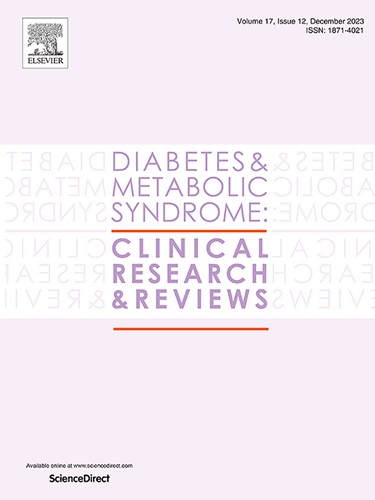印度2型糖尿病患者糖尿病肾病患病率:一项荟萃分析
IF 3.4
Q1 ENDOCRINOLOGY & METABOLISM
Diabetes & Metabolic Syndrome-Clinical Research & Reviews
Pub Date : 2025-06-01
DOI:10.1016/j.dsx.2025.103267
引用次数: 0
摘要
糖尿病肾病(DKD)是2型糖尿病(T2DM)的主要并发症,在全球范围内导致终末期肾病(ESRD),对公共卫生构成重大挑战。2型糖尿病给印度医疗保健系统带来了沉重的负担。因此,本研究旨在估计印度T2DM患者中DKD的总患病率。方法从建库至2024年8月对PubMed和Embase数据库进行综合检索。两名独立审稿人对报告DKD患病率的研究进行了筛选和选择。DKD定义为蛋白尿,肾小球滤过率(eGFR)降低,或两者兼而有之。本研究遵循系统评价和荟萃分析的首选报告项目(PRISMA)指南。使用乔安娜布里格斯研究所(JBI)关键评估清单对所有纳入的研究进行质量评估。还进行了亚组分析和敏感性分析。采用Stata软件进行统计分析。结果荟萃分析共纳入14项横断面研究。印度T2DM患者中DKD的总体患病率估计为44%(95%可信区间(CI): 31% - 56%)。亚组分析显示,印度南部地区的DKD总患病率为45% (95% CI: 29% - 62%),而北部地区的DKD总患病率为42% (95% CI: 8% - 76%)。目前的研究结果显示,印度T2DM患者中DKD的患病率较高。因此,应实施早期预防措施,以减少印度T2DM患者与DKD相关的负担和并发症。本文章由计算机程序翻译,如有差异,请以英文原文为准。
Prevalence of diabetic kidney disease in Indian type 2 diabetes mellitus patients: A meta-analysis
Introduction
Diabetic Kidney Disease (DKD) is a major complication of Type 2 Diabetes Mellitus (T2DM) that contribute to end-stage renal disease (ESRD) globally, posing a major public health challenge. T2DM that poses a substantial burden on the Indian healthcare system. Therefore, the present study aimed to estimate the pooled prevalence of DKD among patients with T2DM in India.
Methods
A comprehensive search of PubMed and Embase databases was conducted from inception to August 2024. Two independent reviewers performed screening and selection of studies reporting DKD prevalence. DKD was defined as the presence of albuminuria, reduced estimated Glomerular Filtration Rate (eGFR), or both. This study adheres to the Preferred Reporting Items for Systematic Reviews and Meta-Analysis (PRISMA) guidelines. Quality assessment of all included studies was performed using the Joanna Briggs Institute (JBI) critical appraisal checklist. Subgroup and sensitivity analyses were also performed. Statistical analyses were conducted using Stata software.
Results
A total of 14 cross-sectional studies were included in the meta-analysis. The estimated overall prevalence of DKD among patients with T2DM in India was 44 % (95 % confidence interval (CI): 31 %–56 %). Subgroup analysis revealed a pooled DKD prevalence of 45 % (95 % CI: 29 %–62 %) in the southern region of India, while in the northern region, DKD prevalence was 42 % (95 % CI: 8 %–76 %).
Conclusion
The findings from the current study showed a higher prevalence of DKD in patients with T2DM in India. Therefore, early preventive measures should be implemented to reduce the burden and complications associated with DKD among patients with T2DM in India.
求助全文
通过发布文献求助,成功后即可免费获取论文全文。
去求助
来源期刊

Diabetes & Metabolic Syndrome-Clinical Research & Reviews
ENDOCRINOLOGY & METABOLISM-
CiteScore
22.90
自引率
2.00%
发文量
248
审稿时长
51 days
期刊介绍:
Diabetes and Metabolic Syndrome: Clinical Research and Reviews is the official journal of DiabetesIndia. It aims to provide a global platform for healthcare professionals, diabetes educators, and other stakeholders to submit their research on diabetes care.
Types of Publications:
Diabetes and Metabolic Syndrome: Clinical Research and Reviews publishes peer-reviewed original articles, reviews, short communications, case reports, letters to the Editor, and expert comments. Reviews and mini-reviews are particularly welcomed for areas within endocrinology undergoing rapid changes.
 求助内容:
求助内容: 应助结果提醒方式:
应助结果提醒方式:


